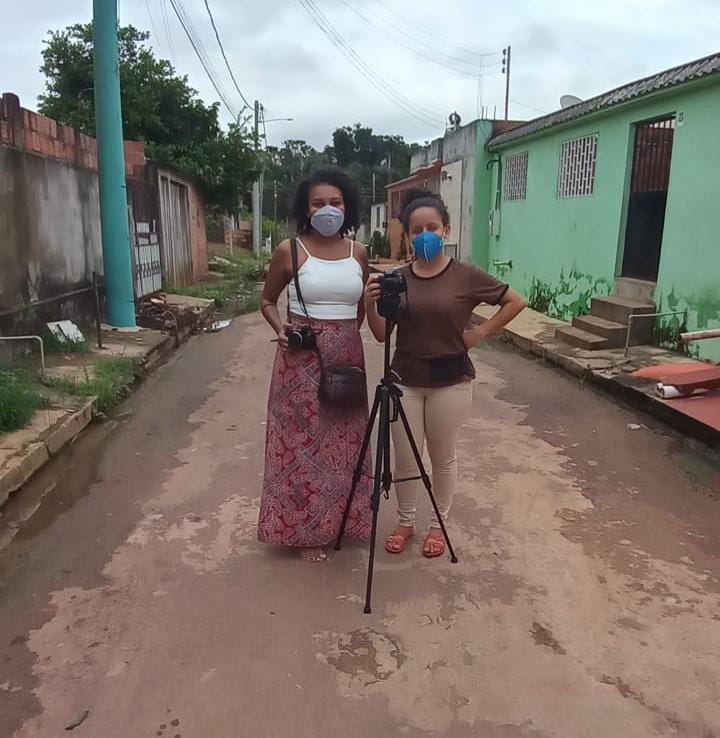In Manaus, Coletivo “Ponta de Lança” uses popular communication to transform narratives in the peripheries
Led by two women, the project shows the reality of the Amazon periphery, telling the stories of its residents


Credit: Disclosure
By: Alicia Lobato – Lupa do Bem / Favela em Pauta
Coletivo Ponta de Lança was founded in 2018 and tells stories, through audiovisual productions, that accurately represent what life is like on the outskirts of the Amazon region.
When they decided to start with Coletivo Ponta de Lança, Raquel Cardoso and Jéssica Valois were looking for a way to intervene in the social context of neighbourhoods and peripheral local communities. With a focus on popular communication, the duo aims to decentralize narratives and show how the northern peripheries are diverse.
This happened after realizing that academic discourse was not accessible to everyone, so the pair decided to change the way they communicate. Thus, they found in the community where they live a way to strengthen the stories of residents of the periphery, who often do not have the space to share them.
During the covid-19 pandemic, the collective realized that it could contribute even more if it acted to combat misinformation about the virus, which was also contagious in communities. They saw in this way, and again, that communication was the answer to the new problem.
After that beginning, the collective wanted to look even more at the periphery. The work began to be developed to show that communities in the North exist in a different way.
Raquel, one of the project’s creators, says that the people they seek to interview to tell stories are mostly inhabitants of the neighbourhoods where they themselves live. For her, the main objective has always been “to empower these narratives that are not seen, are not legitimized as a discourse that speaks of territoriality and is often left on the sidelines”.
Telling stories that traditional media don’t
The founder also states that these stories arise from spaces that make up the city, but which are undervalued. When talking to people with whom they already have some contact, the collective is always well-received and there is interaction throughout the production. She also complements by saying that she found a way to change the speech she learned during her graduation in Literature – Portuguese Language and to use it in a much more practical way in the place where she lives, making clear the objective: “to speak not for them, but together with them”, she says.
With audiovisual productions and using the available social media, productions appear that portray the daily life of the peripheral population, such as the short documentary film “Relatos de Uma Pandemia nas Periferias Amazônicas”, made in 2021. The video has several testimonies from workers in the capital of the Amazonas during the covid-19 pandemic and the reality that many went through at that time.
The various peripheries of the northern region and their own histories
Another work produced by the collective, “Afro-Amerindian Religiosities”, features various religious leaders from religious temples in Manaus, in a reflection on religious racism. This project is part of the series “Periferias e Perspectivas”, which is a space for dialogue and debate on complex issues, according to Raquel.
“We noticed that the suburbs in the North of the country have a different composition, another scenario, their own constructions, which we often don’t realize when we talk about a homogeneous periphery, always based on the Southeast region. Our peripheries extend, they are peripheries that are in the riverside, rural areas and that are built horizontally”, she explains.
Raquel also claims that after this project was published on social networks, people were able to better understand the collective’s proposal, when they also managed to have greater contact with the community, which – according to her – were the people they wanted to reach.
Diversifying this view, producing representative communication, in which more people could identify, also contributed to the strengthening of peripheral neighbourhoods. The collective, today, is invited to occupy different spaces, always guiding the importance of these narratives from the peripheries.
Although Raquel and Jessica are the creators of Ponta de Lança and share tasks among themselves, Raquel explains that the collective acts as a network. “It is made up of young black women from the periphery”, she emphasizes.
To maintain and make the projects viable, they participate in cultural public notices and also work in partnerships with other organizations, carrying out activities together so that they can continue the actions.
Find out more about Coletivo Ponta de Lança
If you want to check out the audiovisual productions made by the collective, you can access the material via the YouTube platform and Instagram profile: @coletivopontadelanca.


